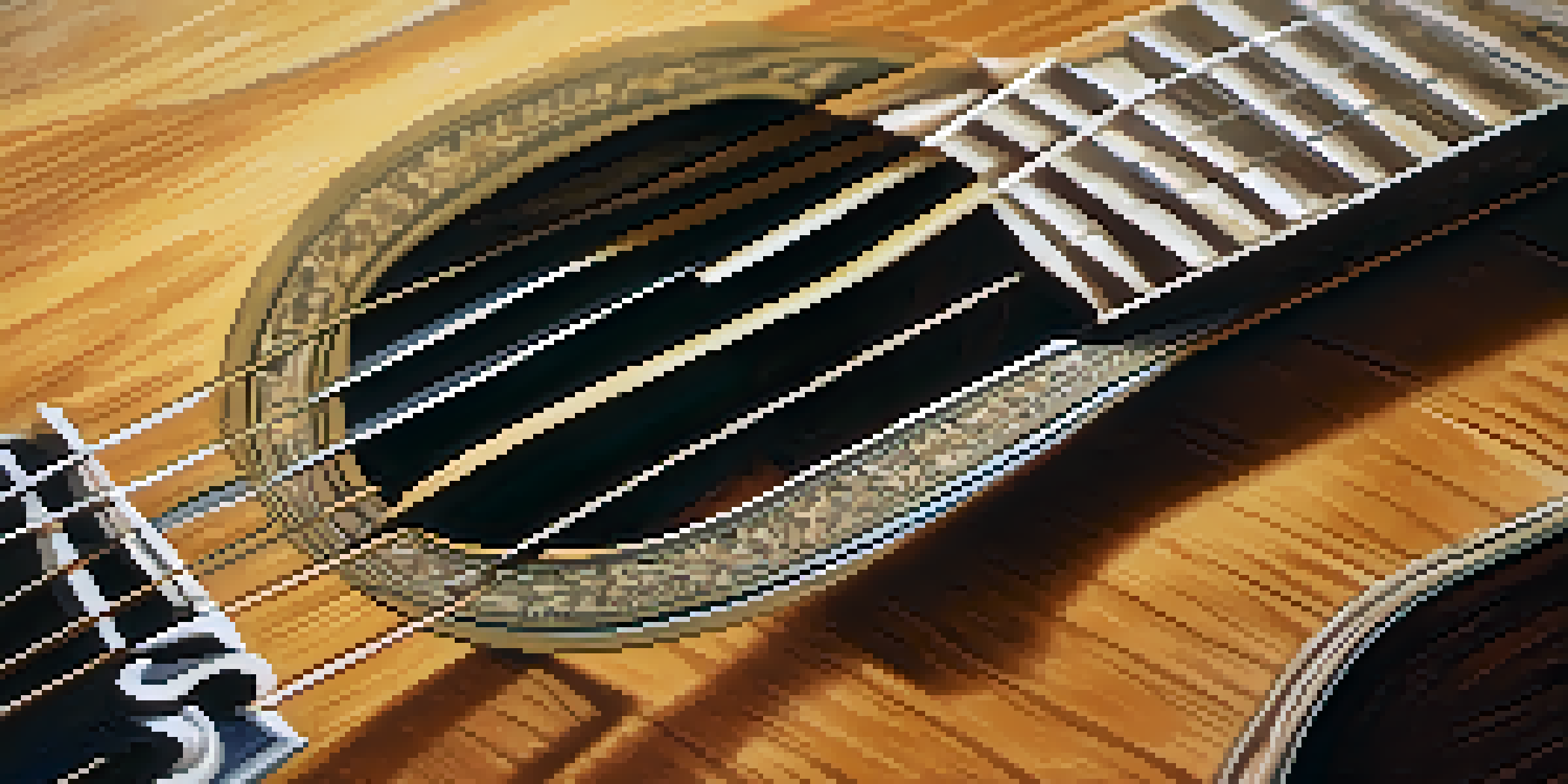Experimenting with Alternate Tunings for Unique Songs

Understanding Alternate Tunings in Music
Alternate tunings involve adjusting the standard tuning of an instrument, often a guitar, to create new sounds. Instead of the usual E-A-D-G-B-e tuning, musicians might opt for D-A-D-G-A-D, which lends a distinct character to their music. This practice allows artists to explore different tonalities and harmonic possibilities that standard tuning may not provide.
Music can change the world because it can change people.
These tunings can evoke various emotions and atmospheres in a song. For instance, a tuning like Open C can give a rich, resonant quality that enhances the lyrical content. By changing the tension on the strings and the relationship between notes, musicians can discover a new world of sonic textures.
Many famous artists have embraced alternate tunings, including Joni Mitchell and Jimmy Page. Their pioneering use of these tunings has inspired countless musicians to experiment and push the boundaries of their sound. Ultimately, understanding alternate tunings is the first step toward unlocking your creativity.
The Benefits of Using Alternate Tunings
Experimenting with alternate tunings can lead to a fresh perspective on songwriting. By shifting the way chords and melodies are constructed, musicians often stumble upon unique progressions that wouldn't have emerged in standard tuning. This can be especially beneficial for artists feeling stuck or seeking inspiration.

Additionally, alternate tunings can make technical passages easier to play. For example, certain fingerings in Open G tuning can simplify barre chords, allowing players to focus more on the emotional delivery of the song rather than technical challenges. This accessibility can encourage musicians of all skill levels to explore their creativity.
Unlock Creativity with Tunings
Exploring alternate tunings allows musicians to discover new sounds and expand their creative horizons.
Moreover, using alternate tunings can help create a signature sound. When a musician develops a style that incorporates specific tunings, it can set them apart in a crowded musical landscape. This distinctiveness not only attracts listeners but can also build a stronger connection with their audience.
How to Get Started with Alternate Tunings
To begin exploring alternate tunings, start by selecting a few popular tunings to try out. Some common tunings include Drop D, Open E, and DADGAD, each offering unique characteristics. You can find plenty of resources online with chord charts and tutorials to guide you through the process.
The best music is essentially there to provide you something to face the world with.
Once you've chosen a tuning, spend some time familiarizing yourself with the new chord shapes and fingerings. Play around with different strumming patterns and progressions to see how they change in this new context. The more you experiment, the more comfortable you'll become with the tuning.
Don't forget to record your sessions! Capturing your musical ideas can help you identify the themes or melodies that resonate with you. Plus, having a library of your explorations can serve as a valuable resource for future songwriting.
Creating Unique Songs with Alternate Tunings
Once you're comfortable with a few alternate tunings, it's time to start crafting unique songs. Begin by playing around with familiar melodies, but in your new tuning. This can lead to unexpected variations that may inspire entirely new compositions.
You can also experiment with layering textures by combining different instruments. For instance, using an alternate tuning on the guitar while adding a straightforward bass line can create a rich tapestry of sound. This layering can enhance the song's emotional depth and complexity.
Unique Sound and Signature Style
Using alternate tunings can help artists develop a distinctive sound that sets them apart in the music industry.
Remember, the key is to let your creativity flow without overthinking it. Allow each tuning to guide you towards new musical ideas, and don’t be afraid to deviate from traditional structures. The beauty of alternate tunings lies in their potential to unlock new avenues of expression.
Examples of Songs Featuring Alternate Tunings
Several iconic songs have been written using alternate tunings, providing great inspiration for budding musicians. For example, 'Blackbird' by The Beatles is known for its use of a unique tuning that adds to the song's ethereal quality. Listening closely to these tracks can reveal how tunings shape their overall sound.
Another great example is 'Kashmir' by Led Zeppelin, which utilizes a form of DADGAD tuning. The song's driving rhythm and haunting melody are deeply influenced by this unconventional approach. It's fascinating to see how these tunings can impact the song's mood and style.
Exploring these examples can motivate you to try creating your own unique songs. Pay attention to how each artist employs alternate tuning to tell their musical story and consider how you might apply similar techniques to your own work.
Challenges of Working with Alternate Tunings
While alternate tunings can be exciting, they also present certain challenges. One of the main difficulties is that each tuning requires a different set of chord shapes and fingerings. This can be disorienting for musicians who are used to standard tuning and may take some time to adjust.
Additionally, collaborating with other musicians can become tricky if they are not familiar with the chosen tuning. It’s important to communicate and possibly even teach your partners the unique aspects of the tuning you’re using. This can be a fun way to share knowledge but may require patience.
Challenges and Collaboration
While alternate tunings offer exciting opportunities, they also present challenges that require practice and communication when collaborating with others.
Lastly, the transition between tunings in a single performance can be challenging. If you’re planning to switch tunings mid-song, ensure you've practiced enough to do so smoothly. With time and dedication, however, these obstacles can become manageable as you gain confidence in your skills.
Incorporating Alternate Tunings into Your Musical Journey
Incorporating alternate tunings into your musical journey can be incredibly rewarding. It encourages you to step outside your comfort zone and discover new facets of your creativity. By regularly exploring these tunings, you can continually evolve as a musician.
Consider setting aside dedicated time for experimentation. Whether it’s a weekly jam session or simply an hour in your practice routine, embracing this exploration can lead to unexpected musical breakthroughs. Consistency is key in developing your skills and finding your unique voice.

As you grow more comfortable with alternate tunings, don’t hesitate to share your discoveries. Collaborate with other musicians, perform your creations, and engage with your audience. Sharing your journey can inspire others to explore the rich world of alternate tunings themselves.